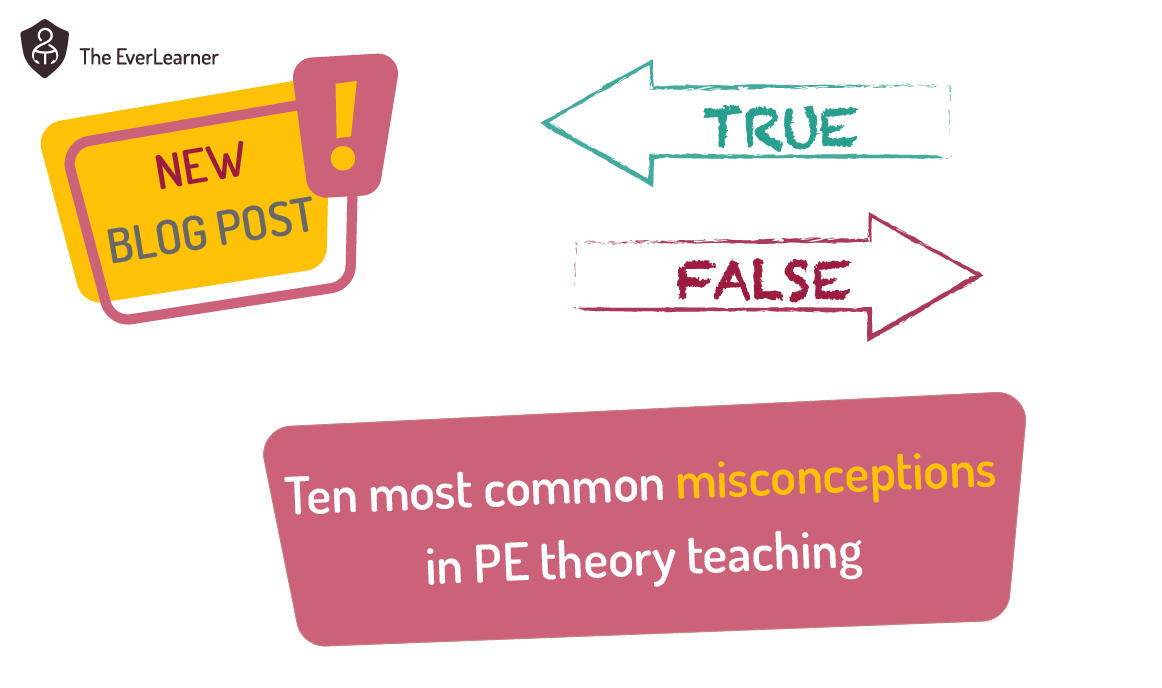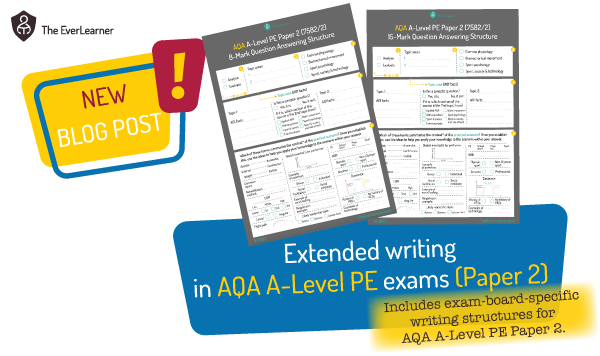Classification of skill in PE: setting the standard
The classification of skills is an extensively studied and assessed topic on a wide range of PE qualifications. From AQA to OCR to Edexcel, from A-level to GCSE to BTEC and beyond, classification is part of the core instruction provided by PE teachers to PE students. Therefore, I wanted to write a guide for us all that we could collectively use as a standard for this topic.
Quick links:
- Why I am writing this post
- The six key continua
- Why do skill classifications matter?
- Classification of skill = Thinking and writing skills
- Muscular involvement continuum (gross and fine)
- Environmental continuum (open and closed)
- Complexity continuum (simple and complex)
- Pacing continuum (self-paced and externally paced)
- Continuity continuum (discrete, serial and continuous)
- Organisational continuum (high organisation and low organisation)
- Bringing classification to life in the classroom
I should be clear: I am not here to write like AQA, Edexcel, OCR or anyone else. The fact that those awarding bodies do not agree on what classifications mean may well be the issue that I am perceiving. Rather, I am here to set a standard, including for the exam boards, about the accurate instruction of classification of skills.
Why am I writing this post
Firstly, I love this topic (classification of skills is officially my 9th favourite topic to teach in PE). Therefore, writing about it is lots of fun. Secondly, we recently went through a recruitment campaign for PE teachers during which one of the assessment tasks was the following:
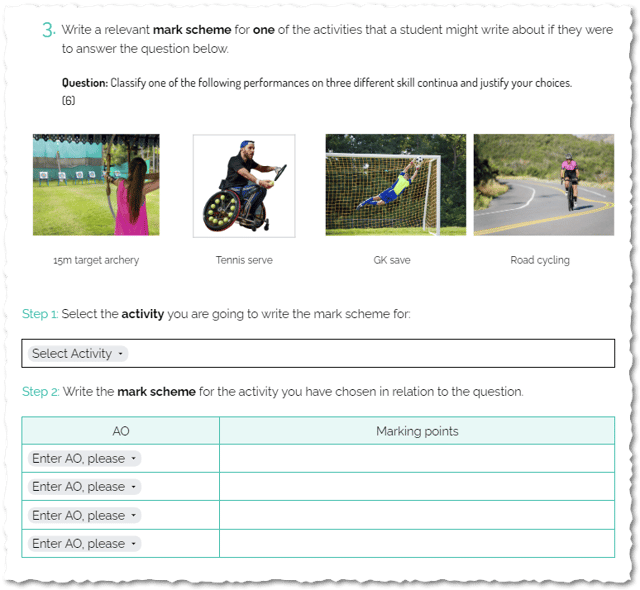
It was really interesting to read the responses of colleagues to this task and, since then, I have had numerous feedback conversations with colleagues including about the classification of skills.
Finally, I posted a fairly frivolous poll on X recently and it got lots of attention:
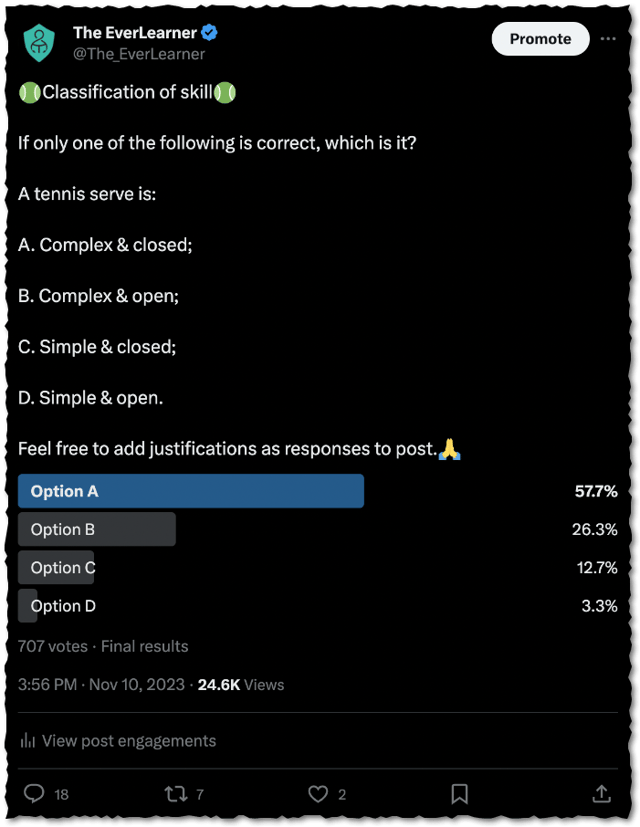
Given that – I would argue – the most correct answer was Option C, I thought colleagues might find it useful to read my views.
The six skill continua
Let’s park any reference to exam boards, courses and levels for a moment. I am going to argue that there are six core classification continua that PE teachers can both practically and theoretically include in their teaching. This can be in reference to a GCSE course, say, but it is also relevant to core PE. I’ll write about why later on.
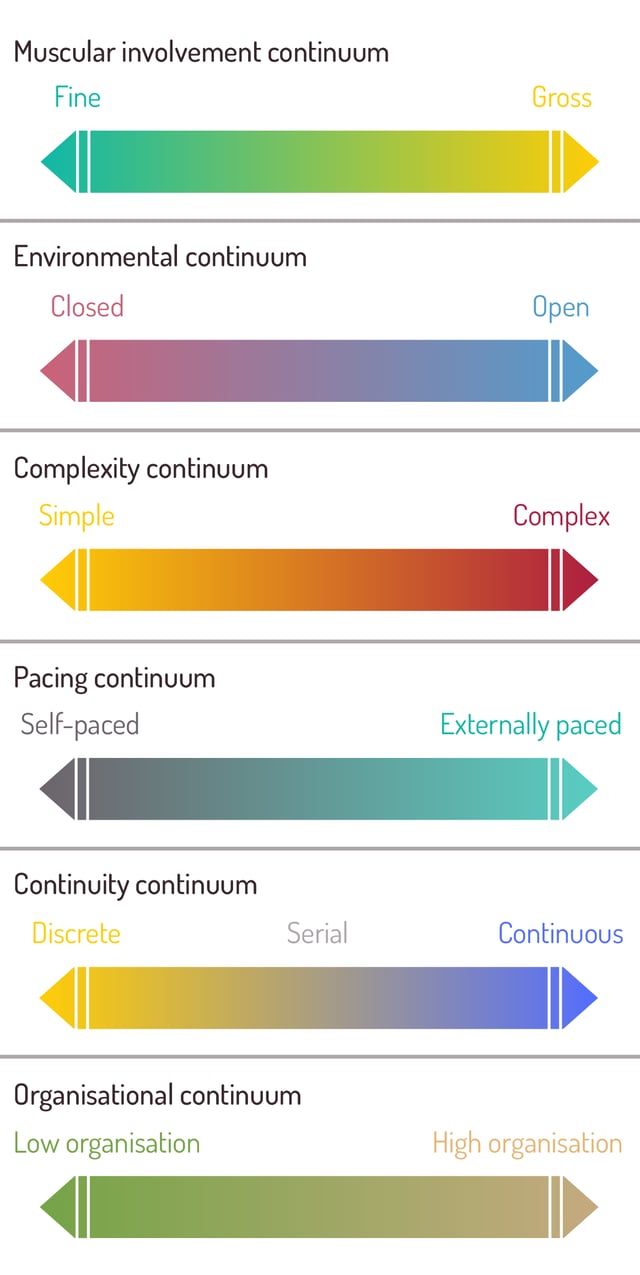
These are the six continua that PE teachers should have a working knowledge of and I will do my utmost to enlighten each one in this article.
Why do skill classifications matter?
There are a few answers to this question but the main one is:
But there are other reasons: it allows students to reflect on the skills they are learning. It allows them to focus on the meaning of different skills. Finally, for GCSE, A-level and BTEC PE and Sport students, it is a requirement of their learning and assessment both in exams and, in some cases, within NEA too.
Classification of skill = Thinking and writing skills
This is important. I want to make a very clear comment here: classification of skills is an ideal topic for teachers to develop practical example skills (AO2) and to develop the "Justify" skill. I urge PE colleagues to specifically focus their attention on these areas because they are significant to students. Take, for example, AQA GCSE PE:
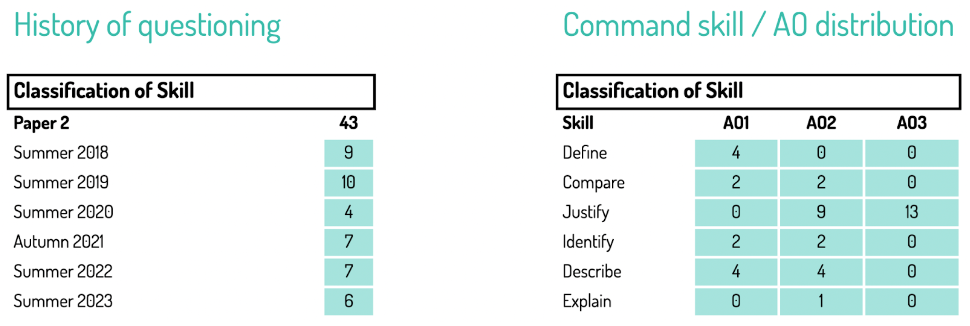
Notice the central importance of the”Justify” skill which makes up over half of all marks assessed on this topic between 2018 and 2023. Notice also that AO2 contributes more marks by some distance than AO1. Therefore, your classification of skill lessons should be targeting these skills.
The muscular involvement continuum
This continuum helps coaches, trainers and teachers as well as learners reflect on the muscular requirements of the skill in question. It also allows them to reflect on the macro intention of the skill. In my opinion, the most exciting aspect of this continuum is that it allows a learner to reflect on the philosophical nature of a particular performance. I will come back to this point in a moment.

The muscular involvement continuum enables an understanding of fine skills and gross skills. These can be described with the following key descriptors:
|
Fine skills |
Gross skills |
|
Involve contractions of small muscle groups. |
Involve contractions of large muscle groups. |
|
Are often focused on coordination, balance or flexibility. |
Are often focused on strength or endurance performance. |
|
Tend to be focused on accuracy and precision. |
Tend to be focused on force output. |
So, this one seems quite simple to understand but the application is far trickier once we begin to grasp the intuition of what sporting movement often is. Let’s start in a simple place: allow me to ask you the following:
Presumably, you would state something like this:

But what happens when we start to challenge the base idea? What about if I asked you about a pommel horse routine in men’s gymnastics? Or about a footballer taking a curling shot around the wall during a free kick in football? Where would you place these examples? If I were to deny you the middle ground (the red bit below) and ask you to justify your placement once you have decided on it, what would you say?

My pommel justification: I have placed the pommel horse just to the gross end because a routine cannot be performed without significant strength. Whilst it is true that the accuracy of the technique is critical to successful performance, this accuracy can only be achieved once the required strength is available to the performer. The really exciting thing about this example is that the more strength a performer attempts to input into the performance, the greater the likelihood of a loss of accuracy. Inversely, in order to be more accurate, a performer may well need to decrease the strength and contractile force in the performance.
My free kick justification: I have placed the free kick just to the fine end of the continuum because effective performance is specifically reliant on the accuracy of the shot and being on target. Without this, the shot is specifically going to be ineffective. However, a hyper-accurate shot is not likely to be effective without force. It is the role of the taker to “trade-off” force and accuracy in order to both be on target and have the ball travel fast enough to defy a capable goalkeeper. I also want to add that I could make a reasonable justification for each of these examples in reverse. Returning to the philosophy point, this conversation really emphasises what the challenge of sport is. It is so often a trade-off. A trade-off, in this case, of force and accuracy with only the very, very best being able to achieve both consistently. It is exciting to have students reflect on this.
The environmental continuum
This continuum helps coaches, trainers and teachers as well as learners reflect on whether the performance environment is changeable. It also allows these people to reflect on the need for adaptation, decision-making and variability of a skill.

So, the environmental continuum enables an understanding of closed skills and open skills. These can be described with the following key descriptors:
|
Closed skills |
Open skills |
|
Few environmental stimuli |
Many environmental stimuli |
|
Consistent and repetitive |
Adapted to the specific scenario |
|
Typically self-paced and simple (more to follow on this) |
Typically externally paced and complex (more to follow on this) |
We need to consider skills that suit these descriptors in order to exemplify them. Let’s use a rugby tackle and putting a shot.

I would argue that a shot put technique is closed by using the terms from above: there are few environmental stimuli, the action is completed repetitively with little adaptation, and it is self-paced and simple. On the other hand, the tackle is completely different: there are loads of environmental stimuli, the tackle technique needs to be adapted to the specific scenario the defender faces, and the tackle is externally paced and complex.
But what about more nuanced examples? What about a centre pass in netball and a 100m relay handover? These examples require us to think very clearly about our justifications. I’ll try my best to do that below. Once again, I have denied the middle ground to force me into a justification behaviour:

My centre pass justification: The centre has to respond to the movement of her teammates in order to make a successful centre pass. Despite there being set moves by team members leading to some level of consistency, the pass fundamentally requires a teammate to find space for a successful reception of the ball.
My relay handover justification: A sprinter’s handover technique is relatively consistent and, although the position of their teammate's hand is an external stimulus, the number of variations remain very few. It could be slightly higher or lower or closer or further away than the previous attempt but the type of adaptation would be quite limited. Therefore, the skill leans towards the closed end of the continuum.
The complexity continuum
This continuum helps coaches, trainers and teachers as well as learners reflect on the perceptual load of different skills. It also allows us to think about the degree of problem-solving and even creativity that might be required in different scenarios. Complexity does not relate to any of the following:
- Ease of learning
- Level of concentration
- How many coordinated body parts are involved in the movement
- How hard it is to do
Sadly, exam boards at GCSE level sometimes do accept these factors. They need to stop doing so in the very next iterations of the qualification.

|
Simple skills |
Complex skills |
|
Low perceptual load |
High perceptual load |
|
Few decisions |
Many decisions |
|
Low problem-solving requirement |
High problem-solving requirement |
Let’s use a hockey penalty flick and a hockey goalkeeper’s save of a penalty flick.

I would argue that the taker is performing a simple skill – in skill acquisition terms… I can barely get a hockey ball off the ground so it’s definitely not “simple” for me! – because there are very few decisions being made beyond the pre-decision of where to place the shot. From my point of view, the goalkeeper’s save is more complex, although not highly complex. The goalkeeper needs to respond to the specific placement, speed and timing of the ball but I have not placed this as highly complex because the range of possible solutions is relatively small. Furthermore, I have assumed that the attempted save would be in response to the ball/flick. The goalkeeper may well use pre-loaded decisions to move in one direction or another. In this case, the complexity drops further. Other goalkeepers will use a blend of pre-loaded and reactive actions in order to attempt the save.
But what about even more nuanced examples? What about a gymnastics beam routine and a golfer’s putt? These examples require us to think very carefully about our justifications. I’ll try my best to do that below. Once again, I have denied the middle ground to force me into a justification behaviour:

My beam justification: A gymnast typically follows a set routine with the sequence and even the timing pre-decided. However, the routine cannot be wholly considered to be simple, as the gymnast has to make constant adjustments in relation to balance. Therefore, the routine is more simple than complex but does have problem-solving elements to it.
My putt justification: A golfer’s putt is far more simple than the beam routine because all decisions are pre-made. Once the stroke has begun during the lift and backswing, there is very little decision-making to consider. If the description had related to something like “a golf putt including all of the planning and assessing”, the skill could be seen as more complex.
The pacing continuum
This continuum helps coaches, trainers and teachers as well as learners reflect on the drivers of a skill. For example, a skill which is self-paced is initiated and sequenced by the performer without significant reference to the external display (external stimuli). But an externally paced skill is initiated and sequenced in specific relation to the external display.

|
Self-paced skills |
Externally paced skills |
|
Initiated when the performer decides to initiate it |
Initiated by an external factor |
|
Speed/rate controlled by the performer |
Speed/rate controlled by the external factor |
Let’s use an athletics event as our trigger. I am choosing to use two different moments of a 60m indoor sprint: a sprint start; and all other parts of the sprint. These skills would be classified as follows:

The sprint start is externally paced, as it is in response to the starter’s pistol. I could go further and state that, specifically, it is the initial push on the block only that is externally paced because once the initiation has occurred, the sprint start technique is self-paced. However, the sprinting itself is entirely self-paced, with the possible exception of a dip for the line if the race is very close.
But what about more nuanced examples? What about a 10-bounce trampolining routine and throwing a punch in boxing? These examples require us to think very clearly about our justifications. I’ll try my best to do that below. Once again, I have denied the middle ground to force me into a justification behaviour:

My trampolining justification: A trampolinist follows a set pattern and decides when to initiate their movements. There remain a small number of external factors that might change the pacing of the routine (such as a loss of position or height) but these remain controlled by the athlete.
My punching justification: A jab or hook or overhand is generally thrown because it is the relevant technique in a particular scenario. For example, a jab will be thrown because the opponent is in the right range but also often because they are coming forward. It is used to push an opponent back. It is true that many punches are thrown in sequences and set moves so this might make the technique less externally paced but the interaction with the opponent’s body means this remains an externally paced skill.
The continuity continuum
This continuum helps coaches, trainers and teachers think about how connected movements are to one another in a sporting performance. It is the only continuum to have three designated positions as shown below.

|
Discrete skills |
Serial skills |
Continuous skills |
|
Skills with a clear beginning and end |
Series of discrete skills linked together |
Skills with no clear beginning and end |
|
In order to repeat the skill, the movement needs to be started again. |
Typically a routine |
The end of one movement is the start of the next. |
Let’s use aquatic activities as our examples:

Swimming lengths or distances is continuous. A dive start (not the following underwater actions) is discrete. An entry, turn and exit from the wall has an element of seriality to it.
But what about more nuanced examples? What about a cricket batting shot, a wicketkeeper’s catch and chasing and fielding a ball that is heading to the boundary? How can we consider these skills to be classified in terms of continuity?

My batting justification: The batsman (this remains the term for a batsperson as of 2023) does have some non-discrete elements to a shot (such as their trigger movements and weight transfer) but the shot still has a clear beginning and end and, in order to complete it again, need to be restarted.
My wicketkeeping justification: The wicketkeeper’s catch is also relatively discrete but there are some sequencing elements to it that lead it to be slightly more central and “serial”. However, in order to make another catch, the skill needs to be restarted.
My fielding justification: Uff, this is a tough one! Running the ball down is definitely continuous but the potential for the action to include a slide, grab, stand up and throw into the wicket means it has a sequential nature too. Hence, it is positioned where I have placed it.
The organisational continuum
This continuum helps coaches, trainers and teachers think about the nature of subroutines within a performance and whether they can be separated and practised in isolation. Skills that can be broken down are referred to as low organisation and those that are difficult to separate are high organisation.

|
Low-organisation skills |
High-organisation skills |
|
Can be easily broken down into different subroutines. |
Cannot be easily broken down into different subroutines. |
|
Are often practised through part-, whole-part-whole or progressive-part practice. |
Are often practised through whole practice. |

A breaststroke technique can be broken down into leg action, arm action, head position, breathing, turn, dive and, in most cases, practised separately. For example, the leg kick can be honed through a range of different isolated practices. However, a road cycling technique is highly organised. The downstroke, the up-pull and the body position are far more difficult to isolate and practise other than in a whole-practice scenario.
But what about more nuanced examples? What about defending an armbar in wrestling, or returning a flick serve in badminton? Where would we position these performances?

My wrestling justification: Defending an armbar is highly organised and it is difficult to break the skill down and practise each part in isolation. The wrestler needs to be placed into a variable scenario against an opponent and perform the entire defence within a whole skill.
My badminton justification: The badminton return can be broken into parts so it leans toward the low-organisation end. For example, a player can practise:
- Ready position
- Initial foot movement
- Large-step to small-step sequences
- The strike
However, the skill, in context, has many elements that should be practised in unison and, thus, it shifts toward the middle a little.
Bringing classification to life in the classroom
In order to show you that I am not just all mouth regarding this topic, I thought the resources below might be of interest. This is, give or take, the information I will use to teach classification, in this case, for AQA GCSE PE...
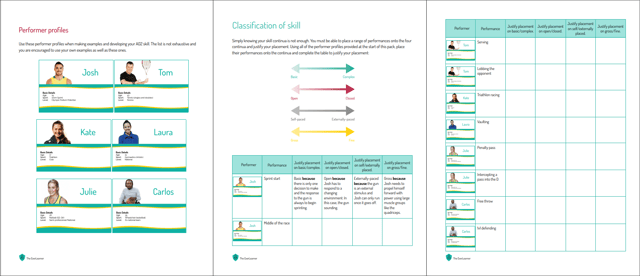
If you wish to access this and other resources, please look for the "Live revision session notes" for the relevant paper on the individual 2023 revision hub pages which you can access from the buttons on the left hand side of the "Live revision 2024 expression of interest" page (you might as well express your interest for our 2024 revision series whilst you are there 😉).
Thank you for reading
%20Text%20(Violet).png)

